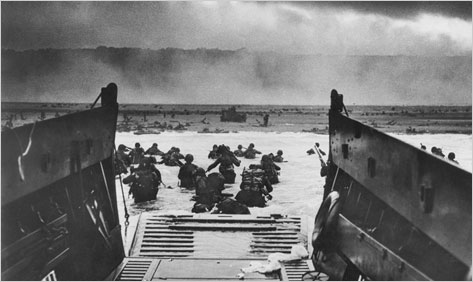D-Day: 24 never-ending hours
 Most things about war have changed since the battle with the Nazis at Normandy. But that day endures. Why is it emblematic?
Most things about war have changed since the battle with the Nazis at Normandy. But that day endures. Why is it emblematic?
In the lead of this NRO piece, the word ‘refreshing’ leapt out as startling.
During a week in which many of the comrades of Sergeant Bowe Bergdahl have expressed outrage at what they say was his betrayal of his country in Afghanistan, it’s refreshing to return to the beaches of Normandy for a celebration of the authentic heroes who stormed ashore here 70 years ago this week.
Northern France was under the boot of Nazi occupation, and was defended by an intimidating array of fortifications and gun emplacements all along its coast. But on June 6, 1944, 160,000 Allied troops landed along a 50-mile stretch of beaches whose names have gone down in history — Utah, Omaha, Gold, Juno, Sword — in what General Dwight D. Eisenhower called a crusade in which “we will accept nothing less than full victory.” More than 5,000 ships and 13,000 aircraft supported the D-Day invasion, and at the cost of 9,000 killed or wounded soldiers, the Allies gained a toehold in Europe that became the staging area for the ultimate defeat of Nazi Germany.
The passage of years has taken its toll on the veterans. Take Pointe du Hoc, a series of 100-foot cliffs that were scaled by U.S. Army Rangers at great peril on June 6. “In 1984, when President Reagan gave his famous speech at Pointe du Hoc, there were 15 busloads of 82nd Airborne troops who had parachuted into France there,” recalls Keith Nightingale, a retired colonel with the 82nd Airborne who has visited Normandy 30 times since his first visit in 1977. “This year, the unit will only be represented by two men.”
But while the ranks of the original veterans are thinning, their places at the lavish commemorations that are held here every five years are being taken by younger generations. Schoolchildren in Normandy are required to learn about “the Liberation,” and many know more about the battle’s disposition of various units than some of the returning veterans. More than 200,000 people are crowding into the Normandy region this week, and more than 12,000 of them — including world leaders from many countries — will attend the main memorial services.
Commentator John Fund pays tribute to why this is still able to happen, and should.
I am visiting Normandy along with members of the Reagan Legacy Foundation, which was founded by Michael Reagan, the president’s oldest son. At a welcoming dinner last night at the château of Alexis de Tocqueville, Reagan noted that his foundation was unveiling a film on the significance of D-Day at the Airborne Museum in Sainte-Mère Église this week. He reminded his listeners that his father died exactly ten years ago, on June 5, 2004. “We are here to honor the veterans but also to honor a president who spoke so eloquently about their sacrifice,” he told me. Indeed, after the dinner a French businessman came up to me clutching a brochure bearing Reagan’s words from his 1984 speech at Pointe du Hoc: “The men of Normandy had faith that what they were doing was right, faith that they fought for all humanity, faith that a just God would grant them mercy on this beachhead or on the next.” The man was visibly moved by the dinner we had just attended, but also moved by Reagan’s long-ago words. “He explained the meaning of it all the best, and we remember both D-Day and him,” he told me.

